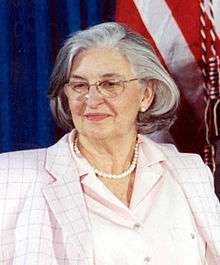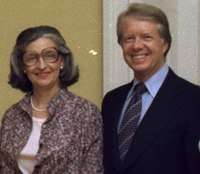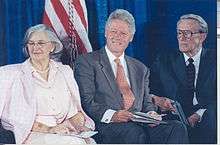Betty Bumpers
Betty Lou Bumpers (née Flanagan; January 11, 1925 – November 23, 2018) was an American politician, advocate for childhood immunizations, and world peace activist, who served as the First Lady of Arkansas from 1971 to 1975.[2] Together, she and Rosalynn Carter ran a successful campaign to ensure that all American school children were immunized. Bumpers was also the wife of the late Dale Bumpers, the governor of Arkansas from 1971 to 1975 and then U.S. Senator from 1975 to 1999.[3][4]
Betty Bumpers | |
|---|---|
 Bumpers in 1999 | |
| First Lady of Arkansas | |
| In role January 12, 1971 – January 3, 1975 | |
| Governor | Dale Bumpers |
| Preceded by | Jeannette Edris Rockefeller |
| Succeeded by | Claudia Riley (acting)[1] |
| Personal details | |
| Born | Betty Lou Flanagan January 11, 1925 Grand Prairie Community Franklin County Arkansas, U.S. |
| Died | November 23, 2018 (aged 93) Little Rock, Arkansas, U.S. |
| Spouse(s) | |
| Children | 3 |
| Occupation | Teacher Activist |
| Known for | Advocacy for immunizations and world peace |
Early life
Bumpers was born in the Grand Prairie community in Franklin County, Arkansas, to salesman and auctioneer Herman Edward "Babe" Flanagan and his wife, the former Ola Callans, a teacher.[5][6] She grew up in Franklin County, except for a period during World War II when her family lived in Fort Smith and in the state of Iowa.[5]
After studying at the Chicago Academy of Fine Arts and Iowa State University,[7] she taught elementary school.[8] In 1949 she married Dale Bumpers, a high school classmate who was then in law school at Northwestern University.[9] After her husband finished law school, the couple settled in Charleston, Arkansas, where Dale Bumpers practiced law and Betty worked as an elementary school teacher.[3] They had three children.[3][9]
Advocacy for childhood immunization
In 1970, Dale Bumpers was elected governor and after his inauguration in 1971, she became the state's first lady.[5] In that role, she decided to focus on the well-being of children and families.[3]
Responding to Arkansas' having one of the lowest rates of childhood immunization in the United States, she initiated a statewide campaign to immunize all of the state's children against childhood diseases.[9] Her Every Child by '74 program, which involved cooperative effort by state government, professional organizations of doctors and nurses, the Arkansas National Guard, the University of Arkansas extension service, faith-based organizations, and other volunteers.[3][4] It was a very successful campaign, delivering immunizations to over 350,000 children on just one Saturday near its peak.[9] As a result of the program, the state attained one of the highest childhood immunization rates of any U.S. state. The Arkansas program was adopted by the U.S. Centers for Disease Control and Prevention as a model for nationwide use.[3][4]
Dale Bumpers entered the U.S. Senate in 1975, and the couple moved to Washington, D.C..[9] Two years later, when Jimmy Carter arrived in Washington as the new President, Betty Bumpers sought his support for a nationwide program of childhood immunization and enlisted the assistance of First Lady Rosalynn Carter.[3][4] After finding only a small number of states required children to be immunized before entering school, the two women joined forces and undertook a campaign to convince every state to adopt this requirement.[9] After just two years of advocacy work focused on individual state governments, they achieved their goal of having all 50 U.S. states require immunization for school entry.[4][9]
A measles epidemic in 1989-1991 that killed more than two hundred children led to a new collaboration between Bumpers and Carter.[10] Concerned that preschool children were vulnerable to preventable illnesses because they were not getting immunized on schedule, they founded the organization Every Child By Two, with the aim of assuring immunizations for all American children by the age of two.[11] Bumpers said that the group's efforts to establish outreach programs and immunization registers in each state had contributed to an immunization rate of 90 percent for children from birth to age two in 2012.[4][9]
Peace Links

A 1981 conversation with her college-student daughter Brooke inspired Bumpers to become a peace activist, focused on ending the nuclear weapons race.[3] While driving together to Washington, D.C., they crossed the Clinch River, the namesake of the Clinch River Breeder Reactor Project, leading Brooke to ask her mother what the family would do in a nuclear war or the aftermath of a nuclear disaster.[9] Bumpers' light-hearted response of "Well, honey, I guess we’d just go back to Arkansas" did not silence her daughter, who responded "Don’t be so stupid, Mother," and asked what would happen if Arkansas was destroyed.[9] The realization her daughter considered nuclear war to be a real threat to her future motivated Bumpers to start a campaign for peace.[9][12]
After discussing the matter with her fellow Senate wives and other like-minded women in Washington, Bumpers decided to work to bring mainstream American women into the campaign for a nuclear weapons freeze, building on her earlier experience with grassroots volunteer activism.[3] She started the organization Peace Links in Little Rock in 1982, Peace Links worked with established women's groups such as garden clubs, parent teacher associations, and church organizations to educate women about the consequences of the nuclear arms race and to engage them in campaigning for world peace.[9][12][13] Within a short time, Peace Links expanded beyond Arkansas and counted some 30,000 members around the United States.[3][9] It operated as a national organization for nearly 20 years, disbanding in 2001 after the end of the Cold War.[3][9]
Later life

In their later years, the Bumpers lived in Little Rock, Arkansas.[14] She and Rosalynn Carter continued to be involved with the leadership of Every Child By Two in her later years.[9] Her husband of 66 years Dale Bumpers died of complications from Alzheimer's disease in January 2016.[15]
On November 23, 2018, Bumpers died from complications of dementia and a broken hip in Little Rock at the age of 93.[14]
Awards and recognitions
The National Institutes of Health Vaccine Research Center was named for Betty and Dale Bumpers in recognition of their efforts to promote childhood immunizations and vaccine research.[3]
Among the awards that Bumpers received were:
- Woman of Conscience Award from the National Council of Women of the United States, 1985[13]
- The first Wilton Peace Prize from the Unitarian Universalist Church, 1986[13]
- Distinguished Citizen Award, jointly presented by the Governor of Arkansas, the Arkansas Office of Volunteerism and KARK-TV, 1987[16]
- Peacemakers Award from the National Peace Institute Foundation, 1989[13]
- Pediatric Nursing Humanitarian Award, 1992[16]
- Surgeon General's Medallion, from U.S. Surgeon General Antonia C. Novello, 1993[16]
- Isaac K. Beckes Award of the National League for Nursing, awarded for service to the League by a non-nurse of national stature, 1997[16]
- Rotary International Polio Eradication Champion award, 1998[16]
- Centers For Disease Control and Prevention Champion of Prevention award, 2000[16]
- Hepatitis Foundation International Humanitarian Award, 2001[16]
- 2005, Induction into the National Women's Hall of Fame[17]
- Billie Ann Myers Paragon Award from the Arkansas Department of Human Services Division of Community Service and Non-profit Support, 2012[9]
In 1994, Peace Links gave her a special Peace Links Founders Award.[13] In 1995, she and her husband shared the Maxwell Finland Award of the National Foundation for Infectious Diseases; in 1998, they shared the March of Dimes Citizen of the Year Award, recognizing their commitment to children's health and polio eradication.[16] The couple also were joint recipients of the Excellence in Public Service Award of the American Academy of Pediatrics.[16]
Bumpers received honorary degrees from Hendrix College in Conway, Arkansas; the University of Arkansas at Little Rock, and the University of Massachusetts.[16][18]
See also
References
- Lockwood, Frank (2016-01-03). "1st lady for 11 days, Claudia Riley dies; Arkadelphian a Democrat stalwart". Arkansas Democrat-Gazette. Archived from the original on 2018-11-24. Retrieved 2015-10-12.
- Bowden, Bill (2018-11-24). "Betty Bumpers, Arkansas' former first lady, dies: She advocated for vaccinations, peace". Arkansas Democrat-Gazette. Archived from the original on 2018-11-26. Retrieved 2018-11-26.
- "Betty Bumpers (1925–)". Encyclopedia of Arkansas History and Culture.
- "Betty Bumpers". National Women's Hall of Fame. Archived from the original on 2013-04-04.
- "Betty Bumpers Interviews". PryorCenter. Retrieved November 23, 2018.
- Barnes, Steve (November 24, 2018). "Betty Bumpers, Campaigner for Childhood Vaccinations, Dies at 93". New York Times. Retrieved November 26, 2018.
- The Encyclopedia of Arkansas History and Culture states she attended the University of Iowa.
- "President Clinton to Visit University of Arkansas". University of Arkansas Newswire. April 9, 2012.
- Martin, Karen (June 1, 2012). "Betty Bumpers On Her Lifetime of Service and Volunteerism". InArkansas.com.
- "NIH Dedicates New Vaccine Research Center to Dale and Betty Bumpers President Clinton Delivers Keynote Address". AIDS Info. June 9, 1999.
- "About Us". Vaccinate Your Family. Retrieved November 23, 2018.
- Lindenmeyer, Kriste (2000). Ordinary Women, Extraordinary Lives: Women in American History. Rowman & Littlefield. pp. 251–253. ISBN 9780842027540.
- "The Peace Links Papers; Description from the Special Collections Brochure Series". Special Collections, University of Arkansas Libraries.
- "Former Arkansas first lady Betty Bumpers dies at 93". Arkansas Online. November 23, 2018.
- Brown, Michael H. (January 2, 2016). "Dale Bumpers, Arkansas politician and barbed wit of the Senate, dies at 90". The Washington Post. ISSN 0190-8286. Retrieved January 5, 2016.
- "Betty Bumpers' Awards and Recognitions". Every Child By Two. Archived from the original on February 22, 2013. Retrieved October 10, 2012.
- National Women's Hall of Fame, Betty Bumpers
- "Institute Welcomes New Board of Directors". United States Institute of Peace. Retrieved October 10, 2012.
External links
| Wikimedia Commons has media related to Betty Bumpers. |
- Betty Bumpers Childhood Immunization Project Papers, University of Arkansas Libraries Special Collections
- Dale and Betty Bumpers Vaccine Research Center
- Betty Bumpers' Life Story on YouTube video of Bumpers
- Appearances on C-SPAN
- Betty Bumpers at Find a Grave
| Honorary titles | ||
|---|---|---|
| Preceded by Jeannette Edris Rockefeller |
First Lady of Arkansas 1971–1975 |
Succeeded by Claudia Riley |